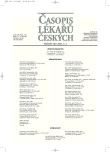-
Medical journals
- Career
Influence of Early Postnatal Nutrition in Preterm Infants on Their Anthropometric and Hormonal Characteristics at the Age of 10 Years
Authors: H. Zamrazilová; V. Hainer; M. Černá 1; M. Kunešová; R. Braunerová; J. Štěpán 2; J. Nedvídková; M. Hill; J. Pařízková
Authors‘ workplace: Endokrinologický ústav, Praha ; Ústav pro péči o matku a dítě, Praha 1; III. interní klinika 1. LF UK a VFN, Praha 2
Published in: Čas. Lék. čes. 2007; 146: 278-283
Category: Original Article
Overview
Backround.
A protective effect of breast feeding on the development of obesity has been clearly demonstrated. Several studies associated higher protein intake in postnatal period with the earlier “adiposity rebound” and the higher BMI in later life.Methods and Results. Twenty eight girls born at 34th week of pregnancy (weight:
2.22±0.31 kg, length: 45.2±2.5 cm, BMI: 11.0±1.5 kg/m²), were subdivided in two groups differing in protein intake during the first postnatal month due to either breast feeding or formula feeding (113.5±18.7 g/month vs. 174.00±14.3 g/month; p<0.0001). Groups did not differ in average body weight, height and BMI at birth. Anthropometric and hormonal characteristics, body composition, energy and macronutrient intakes were determined at the age of 10 years in girls together with parental BMI. Association between the early postnatal nutrition and anthropometric and hormonal indexes at 10 years was evaluated. No significant differences between the groups in anthropometric and hormonal characteristics were found at 10 years except for IGF-1 which was significantly higher in the group with increased postnatal protein intake. Protein intake during the first postnatal month was not related to fat mass and leptin levels at 10 years. Protein intake during the first postnatal month significantly correlated with IGF-1 level, BMI and body circumferences at 10 years. Postnatal fat intake correlates with body circumferences and IGF-1 and also with sagital diameter and leptin at 10 years.Conclusions.
Early postnatal nutrition could encode IGF-1 in later life and this way may be involved in body size programming. Factor analysis revealed IGF-1 as a link between the postnatal energy and macronutrient intake and anthropometric indices and leptin at the age of 10 years.Key words:
postnatal protein intake, anthropometric indices, fat mass, leptin, IGF-1, preterm infants.
Labels
Addictology Allergology and clinical immunology Angiology Audiology Clinical biochemistry Dermatology & STDs Paediatric gastroenterology Paediatric surgery Paediatric cardiology Paediatric neurology Paediatric ENT Paediatric psychiatry Paediatric rheumatology Diabetology Pharmacy Vascular surgery Pain management Dental Hygienist
Article was published inJournal of Czech Physicians

-
All articles in this issue
- The Polycystic Ovary Syndrome and Its Male Equivalent
- Polyglandular Activation of Autoimmunity as a Manifestation of Subclinical Endocrinopathies
- Evaluation of Results of Iodine Prophylaxis in Czech Republic
- Diabetes Mellitus in Adult Patients with Type 1 Diabetes Shows Immunological, Functional and Clinical Differences Depending on the Presence of Autoimmune Thyroiditis
- Endocrine Orbitopathy and Significance of Autoantibodies Against 1D Protein
- Influence of Early Postnatal Nutrition in Preterm Infants on Their Anthropometric and Hormonal Characteristics at the Age of 10 Years
- Relationships Between the „Eating Inventory“ Factors, Socioeconomic Status, Anthropometric Body Adiposity Indexes and Health Risks in Czech Population
- Levels of Hormones in Plasma and in Synovial Fluid of Knee Joint of Patients with Rheumatoid Arthritis
- The Institute of Endocrinology Celebrates its 50th Anniversary. How is the Institute Poised for the Next 50 Years?
- Half Century of the Continuation of the Institute of Endocrinology in Prague
- History, Presence and Trends of Steroid Endocrinology
- Study of the Genetic Causes of Polygenetically Determined Endocrinopathies – Patience Can Bring Success
- Growth Hormone Treatment in the Institute of Endocrinology
- The Role of Complement in Autoimmune Thyroid Disorders
- Quality of Life in the Patients with Disorders of Sexual Development and with Y Chromosome in Karyotype
- Polycystic Ovary Syndrome in 2006
- Neurosteroids and Their Function
- Regulatory Network of Transcription Factors: Their Key Role in the Development and Function of Pancreas
- Genetic Background of Mitochondrial Diabetes
- Obesity Based on Mutation of Genes Involved in Energy Balance
- Osteoporosis and Aterosclerosis – is there Any Pathogenetic Association?
- Journal of Czech Physicians
- Journal archive
- Current issue
- Online only
- About the journal
Most read in this issue- Neurosteroids and Their Function
- Relationships Between the „Eating Inventory“ Factors, Socioeconomic Status, Anthropometric Body Adiposity Indexes and Health Risks in Czech Population
- Obesity Based on Mutation of Genes Involved in Energy Balance
- Growth Hormone Treatment in the Institute of Endocrinology
Login#ADS_BOTTOM_SCRIPTS#Forgotten passwordEnter the email address that you registered with. We will send you instructions on how to set a new password.
- Career

